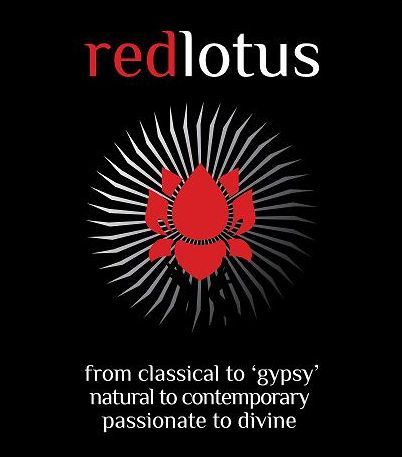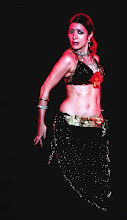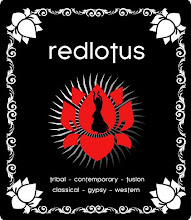::RED LOTUS::
The Lotus is a universal symbol of divinity and purity. Red is a color which invokes particularly feminine energy and images. In the west people often think of red as the color of seduction, passion and desire; a woman at her most vulnerable and powerful point. In India, red represents the divine feminine in the concept of Shakti (power or divine force of the Goddess; as the activating force in the universe). The color red defines the focus on feminine movement which is the unifying theme of this work. Though the dances present in Red Lotus are from far corners of the globe, the aesthetic value of their movements is femininity in its many shades and contrasts.
Each petal of this ‘Red Lotus’ reveals another possibility of feminine strength and grace. Contrasting dance styles are presented such as Western and Indian classical, Spanish and Rajasthani ‘Gypsy’ offering both disciplined and improvisational forms from East and West. These dances are merely different facets of the same spirit. This spirit is explored in the conclusion with a Fusion Belly Dance piece.
::DUET::
The Bond:
The personal sacrifices and determination of each artist is immediately recognizable in their dedicated approach to dance. Patricia Passo, moved to Spain from Brazil to learn Flamenco and other dances influenced by the Arabic presence in Spain throughout history, while Colleena moved from America to India, to immerse herself in both classical and ‘Gypsy’ dances of India.
The artist relationship of the two dancers is based on a similar experience with dance in their life. As foreigners entering into dance traditions of their adopted land, they have been able to keep a clear idea of who they are as individuals within the personality of their chosen dance form. An outside perspective along with a diverse background in dance allows them to understand nuances about traditions which others may take for granted. They both describe not only their dance, but their lives as ‘fusion’.
The Movement:
Colleena and Patricia have both done their preliminary training in classical dance. Patricia studied at Uni Rio University, at Espaço Novo Ángel Vianna in Brazil and at Complutense University and Rey Juan Carlos I University in Spain. Colleena is trained in Odissi classical dance under the careful guidance of Guru Shree Padma Cheran Dehury in India. The structure of classical dance has set a strong foundation which allows their dance practice to remain focused and aware of subtleties as they create their own fusions. Classical dance, whether in the East or the West, aims to reshape the muscle habits to move in a very specific line of movement until it becomes a new nature to the artist. Their physical discipline remains in tact even as they bring primitive, Gypsy and contemporary movement together in one body, creating a unique awareness in improvisational and traditional dances.
:: SPECTACLE: A New Work in Dance ::
From Classical to ‘Gypsy’… Natural to Contemporary… Passionate to Divine…
This performance leads us through the contrasts and fusions in the works of Patricia Passo and Colleena Shakti.
Elemental dance forms:
Odissi Classical Indian Dance
Western Classical and Contemporary Dance
Flamenco: Spanish ‘Gypsy’ Dance
Rajasthani ‘Gypsy’ Dance
Fusion ‘Belly Dance’
Act.1 SPIRIT: Introducing the Function of all dance. Pushpanjali is the offering of flowers at the beginning of a performance. In Indian philosophy it marks the auspicious opening of a prayer in the form of dance.
Act.2 BODY: Form Classical Dance from East to West: activating different studied forms of communication. Imagine two women talking about the sacrifices made in their life on their search for freedom… each one speaks a different language yet the stories share much similarity.
Act.3 EARTH: Feeling “Gypsy” Dance - Rasa and emotional movement of the human experience. Emotion creates a reaction. Reaction is movement, and for some, that reaction defines their whole being. Act. 3 relates the similarities and differences of traditional dances based on the experiences of women living as ‘outsiders’ of their society.
Act.4 FREEDOM: Integration of form and feeling - Fusion. If technique gives us freedom, emotion challenges the limits of our form. Fusion is the natural evolution of those seeking beyond their expectations. True self expression is unique beyond categorization.
:: INTEGRATION: Expert Dance Instruction ::
Dance workshop topics:
1. FORM: Postures, balance, turns, movement quality, etc.
· Western classical / contemporary dance technique
· Indian classical dance technique
· Applying Western and Indian methods in unified movement
2. FEELING: Experience and expression through traditional folkloric dances.
· Flamenco
· Indian/ Rajasthani
· Comparative movement
3. FUSION: Applying foundational tools in a fusion choreography.
“Within the city of Brahman (spirit), which is the body, there is the heart, and within the heart there is a little house. This house has the shape of a lotus, and within it dwells that which is to be sought after, inquired about, and realized.
What then is that which dwells within this house, this lotus of the heart?
Even so large as the universe outside is the universe inside within the heart of the lotus. Within it are heaven and earth, the sun, the moon, the lighting, and all the stars. Whatever is in the macrocosm is in the microcosm…
Though old age comes to the body, the lotus of the heart does not grow old. It does not die with the death of the body. The lotus of the heart where Brahman resides with all his glory – that, and not the body, is the true city of Brahman.”
Tuesday, March 3, 2009
Subscribe to:
Post Comments (Atom)




No comments:
Post a Comment